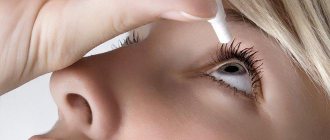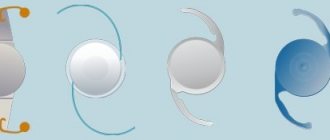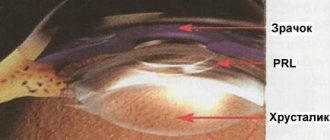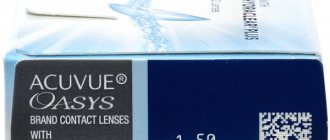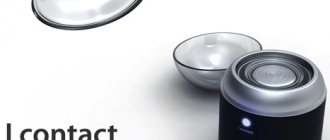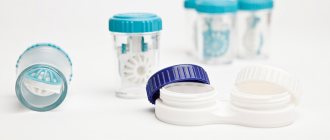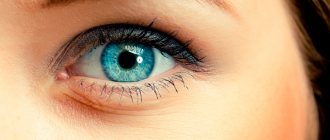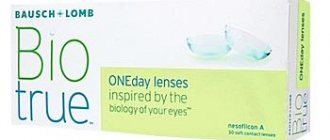Contact lenses are a widely used means of vision correction. Unlike glasses, contact lenses are in direct contact with the cornea and conjunctiva and can cause changes in the anterior segment of the eye, which are classified as complications and require treatment.
Causes of complications when wearing contact lenses:
→ the occurrence of relative hypoxia due to limited oxygen supply to the eye tissues,
→ changes in metabolic processes,
→ mechanical and toxic-allergic effects of lenses and care products on the eyes.
Depending on the cause of occurrence, mechanical, hypoxic, toxic-allergic, inflammatory and infectious complications of contact vision correction are distinguished.
| Mechanical damage (surface deformation, epithelial damage to the cornea and conjunctiva) occurs when contact lenses are incorrectly selected, air bubbles accumulate under the lens or a foreign body enters under the lens, the use of a damaged or contaminated contact lens, as well as contact lenses with a high elastic modulus of the material (hard or first generation silicone hydrogel lenses). |
Hypoxic complications can occur due to inadequate selection of contact lenses or the use of lenses with insufficient gas permeability
and are clinically manifested by symptoms of edema, vascularization (ingrowth of blood vessels into the cornea) and expansion of the vasculature along the edge of the cornea.
| Toxic-allergic complications (papillary conjunctivitis, corneal epitheliopathy) arise due to the reaction of the eye to lens care products , deposits on the surface of the lenses, and, in rare cases, to the lens material. |
Inflammatory and infectious eye lesions (sterile infiltrates, microbial conjunctivitis and keratitis) are among the most serious complications that arise when wearing contact lenses. The risk of developing an infectious process increases if the wearing regime is violated.
and recommendations for lens care in case of non-compliance with hygiene rules and the presence of chronic eye diseases.
| The incidence of complications of contact vision correction varies from 3% to 20%. However, some complications (eg, corneal staining) can occur in 50-80% of cases. The severity and frequency of complications of contact vision correction depends on the type of lens, the adequacy of its selection, the environment, the characteristics of visual work, as well as the individual characteristics of the eye. |
What can be the consequences of wearing lenses?
The consequences of long-term wearing of contact lenses can be either easily corrected or very severe, causing serious eye diseases. Often the situation is complicated by the fact that at the initial stages it is difficult to determine the true cause of discomfort, which may lie in eye pathology and the characteristics of the selected lenses: their material, type, gas permeability and moisture content. The most common consequences of using contact optics include:
- Swelling of the cornea;
- Excessive deposition of protein formations on the surface of the lenses;
- Conjunctivitis;
- Dry eye syndrome;
- Proliferation of blood vessels;
- Keratitis;
- Corneal ulcer;
- Allergic reactions.
Let's look at each of them in more detail.
Consequences associated with incorrect selection of lens sizes
Only an ophthalmologist can advise you on how to choose the size of contact lenses; when selecting lenses, the doctor always evaluates the fit of the contact lenses on the cornea. Normally, the lens should completely cover the limbus area, shift by 1.5-2 mm when blinking, and during a push-up test easily move and return to its original position - this is the correct, safe fit of the lenses. With a loose fit, the contact lens is too mobile and decentered.
With a tight fit, the lens moves less than 1.5-2 mm or does not move at all. With such a planting, metabolic processes in the cornea are disrupted due to hypoxia. The edges of the lens compress the vessels of the limbal zone; insufficient exchange of tears in the space between the lens and the cornea leads to the development of complications.
Ophthalmologist Natalya Gusakova
Dina R 04/02/18 Hello, I have been wearing contact lenses for 18 years. In recent years I have been wearing Oasys (2 weeks). 1.5 years ago I bought glasses for the first time and decided to wear them at least once a week. Whether it was because of this or not, after a couple of months, sudden problems such as dryness and watery eyes began to appear both while wearing lenses and while wearing glasses. And maybe 10 minutes of discomfort, then normal. Or 3 days of redness (without pus, etc.), normal again. Doctors say that the eyes have become accustomed to the moisturizing component built into these lenses, so the lenses need to be changed. I've been trying new lenses for a year now. I definitely don’t like biofinity - it dries before my eyes and I just peel it off in the evening. I use drops. I liked Bausch+Lomb Ultra, but apparently they also use additional hydration - MoistureSeal technology... Questions: 1. Are lenses like Oasys really addictive or is it marketing? (they persistently sell Biofinity) 2. Are there spectacle lenses that do not distort?
Natalya Gusakova 01/16/17 Dina, hello! The consequences of wearing colored lenses are exactly the same as those of wearing regular, clear lenses.
Dina 01/14/17 Hello Natalya. Tell me, will the consequences of wearing colored lenses be the same as when wearing contact lenses, or do they have their own characteristics?
Corneal edema
A deviation such as corneal edema most often occurs due to an insufficient amount of oxygen supplied to the visual organs, which may be directly related to incorrectly selected curvature of the optical product (an individual parameter for each patient), their nighttime use during sleep, overwear or material characteristics.
The main signs of corneal edema are: blurred image, “rainbow” when looking at bright light, pain during prolonged use of lenses, redness.
This consequence can be eliminated in a few days if you consult a specialist in a timely manner.
Formation of protein deposits
A very common manifestation, which is quite natural when wearing optical products with a long period of use. The fact is that the proteins, lipids and calcium that make up the tear fluid come into direct contact with the surface of the lenses.
When the components of tear fluid accumulate on the surface of the lens, a non-uniform film appears, it can distort vision and cause irritation of the visual organs, itching and redness.
If the user does not follow the rules of hygiene and lens care, infectious eye diseases may occur. That is why experts strongly recommend daily cleaning of optical products with a multi-purpose solution that contains special enzymes to eliminate such deposits.
If the problem of lipid and protein formations occurs too often, it is better to use contact optics made from materials containing Comfilcon A or Netrafilcon A, which make the surface of the lenses more resistant to the accumulation of proteins and lipids. It is also worth considering daily replacement products that do not require maintenance. At the end of the day, you dispose of your used pair and put on a new pair in the morning. In a short period of wearing, such formations do not have time to appear on the surface of the product, so any danger is excluded.
It is very important to understand that protein deposits are a potential cause of various infections, and their rough surface can cause microtrauma to the cornea.
Conjunctivitis
This eye disease from lenses can occur due to the presence of allergens in the composition of care products, as well as accumulated protein formations and other contaminants (for example, cosmetic residues). Conjunctivitis appears as a small bulge at the top of the eyelid. Signs of pathology: itching, lacrimation, irritation, sensation of a foreign object in the eye.
To eliminate capillary conjunctivitis, it is recommended to avoid the use of contact lenses until the problem is completely resolved. The specialist will help you select other optical products based on the material, prescribe medications that prevent the development of mast cells, and drops that eliminate discomfort.
Dry eye syndrome
Very often, users who wear contact lenses for a long time develop dry eye syndrome or, as experts call it, keratoconjunctivitis. As a rule, the disease occurs due to prolonged and intense work at the computer, being in a room with dry air and a deficiency in the production of tear fluid by the visual system.
To eliminate discomfort, doctors prescribe medications containing the same components as human tears (for example, hyaluronic acid).
On the modern optics market, there are special lenses that eliminate the symptoms of the disease, which are created specifically for sensitive eyes and are able to retain moisture on the surface for as long as possible. It is also advisable for people with dry eye syndrome to use additional moisturizing drops and gels.
Ask an ophthalmologist
If all of the above does not convince you to give up contact lenses, then in conclusion - a few more tips that the patient should receive from an ophthalmologist who prescribes contact lenses. Experience shows that many people do not even know this. — After selecting contact lenses and learning how to put them on correctly, the patient should receive information on how to behave in case of various problems: for example, if the contact lenses do not come off (this sometimes happens after the first use). In this case, you need to know in advance where you can go in the next 24 hours. — You should only use the contact lens solution that is recommended for your type of contact lens. In addition, some solutions contain components that cause allergic reactions in certain people. The same goes for contact lenses themselves: you may not tolerate a certain type of contact lens, or a certain brand of contact lens, but others will work for you. — Long-term wear of contact lenses reduces the access of oxygen to the eye and increases the likelihood of infectious eye diseases several times. Therefore, some ophthalmologists do not recommend getting carried away with such contact lenses, although they are now increasingly popular. — It is not recommended to wear contact lenses for longer than the specified period: for example, re-wearing disposable ones or “stretching” for a month those that are intended to be worn for 2 weeks. Such “savings” often lead to dire consequences. — Contact lenses should not be washed in soapy water or homemade solutions. By the way, one of the most common cases of infection in the eye is when the owner of a contact lens tries to rinse it with his own saliva, without having a solution on hand. Even tap water, although not very pure, will be a healthier solution in this case. But it’s still better to carry the solution with you. — A separate discussion with your doctor requires the use of contact lenses in unfavorable environments: for example, in enterprises with high levels of dust and various chemicals in the air. You can wear contact lenses in these conditions if you have additional protective equipment (special glasses), but in some cases they are completely excluded.
MedNovosti.ru
Vessel proliferation on the cornea
Due to improperly selected soft contact lenses, proliferation of blood vessels on the cornea of the visual organs can occur. The reason for this is the insufficient amount of oxygen supplied to the cornea. This consequence is often associated with the use of contact optics with daytime mode during sleep. If the user needs to sleep in optical products, it is worth choosing night lenses, that is, with a flexible or prolonged mode of use.
How to stay healthy
Proper cleaning and disinfection of contact lenses is a vital part of contact lens care.
Never confuse or replace one procedure with another. Follow your ophthalmologist's instructions and you will enjoy clear vision. And the health of your eyes will always be normal with contact lenses. The information on our website is provided for informational purposes only and should not be used as an experiment without the advice of an ophthalmologist or other medical expert. We do not accept any responsibility for your actions taken without the approval of your ophthalmologist.
Microbial keratitis
This complication is one of the most dangerous and can lead to complete loss of visual ability. Despite the fact that the visual apparatus is designed in such a way that it independently prevents infection by washing the cornea with tear fluid, obsolete cells die off during its functioning and can remain on the surface of the lenses.
The occurrence of microbial keratitis can occur in people who continuously wear night lenses; the consequences are the appearance of microorganisms such as staphylococcus or Pseudomonas aeruginosa. Patients experience profuse lacrimation, burning, photophobia, and purulent discharge.
Therapeutic soft contact lenses. Application
The idea of using contact lenses for medicinal purposes and practical attempts to implement it date back to the beginning of the nineteenth century. A significant limitation of the use of glass lenses for incomplete closure of the palpebral fissure was the rapid development of hypoxia and poor tolerability. At that time, the feasibility of using therapeutic contact lenses only to protect the cornea was considered. The appearance in the early 60s of the last century of hydrophilic materials for the manufacture of soft contact lenses (SCLs) opened up new prospects for their therapeutic use. Ophthalmologists in various countries began to use SCL primarily for the purpose of bandage (protection) for diseases and injuries of the cornea. Bandage SCL
Bandage SCL is a biologically inert bandage, permeable to oxygen. The lens, due to its elasticity, follows the relief of the cornea and creates a stable protective and stabilizing surface. Bandage SCL provides mechanical protection of the cornea:
- completely relieves or weakens “corneal syndrome” (pain, photophobia, lacrimation), which occurs with burns, wounds and many diseases of the cornea, due to the coating of the cornea (protection of nerve endings) and reducing the traumatic effect of the eyelids on the cornea when blinking; — accelerates the regeneration of the corneal epithelium and scarring processes; - reduces the evaporation of tear fluid from the surface of the cornea. All this together creates a feeling of comfort for the patient. Advantages of bandage SCL
Unlike a conventional bandage, a bandage SCL allows the doctor to evaluate the dynamics of the affected eye (without removing the lens), does not interfere with the administration of medications, the measurement of intraocular pressure through the use of non-contact models of tonometers through the lens, and, if indicated, provides the patient with vision correction (using therapeutic-corrective lenses) and cosmetic effect (using therapeutic and cosmetic lenses). SCL in medical practice
Of particular interest is the use of SCL as a fundamentally new dosage form of intensive therapy that meets the requirements of modern ophthalmology. The lens is a carrier of drugs, prolongs their action and helps create stable therapeutic concentrations of the drug in the tissues of the anterior segment of the eye.
Numerous experimental studies have made it possible to establish the basic patterns of distribution in the eye of drugs of various pharmacological groups administered using SCL. Lenses saturated with a drug create a certain reserve of the drug, ensuring its long-term targeted delivery to the eye tissues. This property allows you to reduce the number of instillations; makes it possible to reduce the dose of the drug while maintaining its effectiveness, thereby reducing toxicity, which ultimately reduces the risk of side effects. Advantages of SCL in treatment
In some cases, SCLs have an advantage in the treatment of severe corneal diseases (endothelial-epithelial corneal dystrophy, recurrent erosions, multiple non-penetrating corneal wounds) resistant to conventional treatment methods. However, it is obvious that the distinction between therapeutic SCLs into bandage and dosage forms for transporting and increasing the exposure time of drugs injected into the eye is very arbitrary, since the result of the therapeutic effect when using SCLs consists of both interrelated components. What lenses are used as therapeutic lenses?
As a rule, highly hydrophilic (water content more than 50%) SCLs are used as therapeutic lenses, usually having zero or weak degrees of optical power. The high degree of hydration of the SCL material provides oxygen permeability (Dk) of the order of 20-40 units. When SCL is explanted into the eye, it reduces oxygen access to the corneal epithelium and serves as a barrier to the removal of corneal metabolic products. When the eye is open, oxygen availability depends mainly on the oxygen transmittance of the lens (Dk/t) and the additional amount of oxygen in the tear fluid under the lens. The latter plays a secondary role for hydrogel SCLs. With closed eyelids, the value of the Dk/t coefficient becomes even more noticeable, since the access of oxygen to the cornea can be increased either by increasing the oxygen permeability of the SCL material, or by ultra-thin design. The most promising for therapeutic use are silicone hydrogel SCLs, the material of which is a unique combination of silicone with high oxygen permeability (Dk - 140 units) and hydrogel. Silicone hydrogel SCLs do not cause chronic metabolic stress caused by exposure to hypoxia (lack of oxygen) or hypercapnia (increased concentration of carbon dioxide) - a potential cause of complications in the anterior segment of the eye. The high effect of silicone hydrogel SCLs is associated not only with their oxygen permeability, but also with reduced moisture content, due to which dehydration is reduced and the process of deposit formation on the lens is slowed down. In addition, long-term wear reduces the risk of infection caused by lens handling. The new generation of SCLs made of silicone hydrogel materials fully meets the requirement for oxygen permeability for long-term wear. In particular, the Airoptix Night & Day SCL (CIBA Vision) has been recommended by the FDA for continuous therapeutic use (up to 30 days) and is the lens of choice when used for therapeutic purposes. In recent years, silicone hydrogel lenses from other companies have also been approved for therapeutic use: Acuvue Oasys Jonson & Jonson and Pure Vision Baush & Lomb. Despite the fact that the new generation of SCLs with high oxygen permeability exceeds the therapeutic effect of SCLs with low Dk and guarantees a minimum number of complications during use, in some cases (as an exception) it is possible to use SCLs of previous generations. If it is necessary to protect the corneal epithelium and prevent epithelial or stromal edema, the lenses of choice are silicone hydrogel SCLs with a high oxygen permeability index or ultrathin lenses. However, when solving a specific clinical problem, in each case it is necessary to choose exactly the lens that will most contribute to improving the condition of the cornea. In what cases are SCLs indicated?
The greatest effectiveness of therapeutic SCLs has been shown in the treatment of endothelial-epithelial corneal dystrophy (ECCD), which can develop as a result of perforated wounds of the eye and repeated surgical interventions. The appointment of therapeutic SCL for this pathology significantly improves treatment outcomes, helping to weaken the corneal syndrome, epithelization of the cornea and reduce its swelling, prolonging the action of local pharmacotherapeutic drugs. For a similar purpose, the use of therapeutic SCLs is indicated for a number of serious diseases such as long-term non-healing, recurrent corneal erosions and corneal ulcers. According to some data, therapeutic SCLs are advisable to use in the early stages for viral lesions of the cornea. Their role is auxiliary - reducing pain, prolonging the effect of antiviral drugs, and some improvement in vision during drug treatment. One of the medical indications for the use of highly hydrophilic LMCLs is dry eye syndrome. Among the therapeutic measures, in addition to hygienic procedures and replacement therapy, the administration of LMCL not only stabilizes, but also improves the condition of the tear film. Biocompatible SCLs are considered preferable for dry eye syndrome. There are reports of the possibility of using silicone hydrogel SCLs for dry eye syndrome. In addition to the high oxygen permeability of silicone and the moisturizing properties of the gel, the low moisture content of the lens material contributes to the resistance of silicone hydrogel SCLs to dehydration. Therapeutic SCLs are also indicated for protecting the cornea in cases of descemetocele (prevention of corneal perforation), trichiasis; traumatic lagophthalmos (eyelid defect, cicatricial eversion of the eyelids or retraction of scabs from stage IIIb-IV eyelid burns) or neurological nature. To date, the scope of therapeutic use of SCL (mainly for bandage purposes) has extended to ophthalmic surgery. Use of SCL for injuries
For corneal injuries, therapeutic SCLs are indicated for use in the following cases:
• for non-penetrating deep and valvular wounds with pronounced corneal syndrome, for small penetrating wounds that do not require microsurgical treatment, therapeutic SCLs are installed during the initial examination; • for corneal wounds with uneven edges, when it is not possible to achieve complete sealing with sutures, the LMCL is put on the eye either immediately immediately after surgery after suturing is completed, or in the early postoperative period; • the use of LMCL is indicated for poor tolerance of corneal sutures - as patient complaints arise; after removal of corneal sutures - with an insufficiently formed scar and the presence of filtration; • when providing first aid to patients with perforated eye wounds, the application of SCL provides the so-called “transport sealing”, which prevents the underlying membranes from falling out during the evacuation of the victim and helps bring the edges of the wound closer together; • the use of antibiotic-saturated LMCL at the stage of specialized ophthalmological care allows you to refrain from primary surgical treatment until the wounded person arrives at the next stage (for corneal wounds no more than 3 mm in length, even in the presence of filtration of moisture in the anterior chamber of the eye). With extensive wounds of the cornea, the time for primary surgical treatment of the wounded eye is reduced by reducing the number of corneal sutures; • the use of therapeutic SCLs is indicated when it is necessary to delay surgical intervention in case of descemetocele, corneal fistula, in poor general condition of the patient or due to the lack of donor material, as well as as a temporary measure to seal the corneal wound before radical surgery. Today, based on experimental and clinical studies, we can talk about the effectiveness of the therapeutic use of SCL in the following pathological conditions: • thermal and chemical burns of the cornea of I, II, III degrees; • combined thermomechanical lesions of the organ of vision with the dominance of corneal syndrome; • non-penetrating wounds of the cornea with the presence of multiple foreign bodies in the superficial layers; penetrating wounds of the cornea with a wound length of no more than 3 mm and not requiring sealing sutures; • penetrating wounds of the cornea after surgical treatment with interrupted sutures; • filtration of a postoperative wound. Therapeutic SCLs pre-saturated with antibiotics can be used to prevent infectious complications in eye wounds, before operations involving opening the eyeball, as well as in the treatment of infectious complications of eye wounds as part of a complex treatment. Therapeutic SCLs are used quite successfully in the postoperative period of refractive laser operations. Modern recommendations indicate that in these cases, only silicone hydrogel SCLs (with a maximum oxygen permeability of the material) should be used immediately after surgery, with continuous wear for up to 2-3 days. The therapeutic value of these lenses, in addition to the bandage function, lies in the supply of oxygen-enriched tears to the cornea, which significantly accelerates the process of its regeneration. Modes of use of therapeutic SCLs
Patients receiving therapeutic SCLs must be under strict medical supervision. The first examination by an ophthalmologist after starting treatment is recommended the next day, a second examination after 3-5 days, then weekly examinations for a month or more, depending on the condition of the patient’s eye. On average, the frequency of inspections ranges from once every 3 days to once a month. The duration of treatment using SCL varies greatly and is dictated by the nature of the pathological process. For chronic eye diseases, this period ranges from six months to two years. In the treatment of acute inflammatory diseases of the cornea, the duration of use of therapeutic SCL ranges from 2 to 3 weeks. The duration of use of therapeutic SCLs in postoperative patients depends on the severity of corneal syndrome and the timing of scarring (usually before removal of sutures). For patients undergoing laser refractive surgery, therapeutic SCLs are prescribed immediately after surgery for 2-3 days. Therapeutic SCLs, given the extended period of their prescription, have a tendency to accumulate deposits. This dramatically reduces wearing comfort and can cause eye infection. In this regard, the timely replacement of therapeutic SCLs is of particular importance. The SCL must be replaced by a doctor. As a rule, this procedure is carried out weekly. It is advisable to prescribe therapeutic SCLs in a one-time use mode, and use new sterile SCLs for replacement.
In conclusion, it should be emphasized that the effective and safe use of therapeutic SCLs requires compliance with the following conditions:
— correct selection of SCL (lens type, lens parameters, individual wearing regimen); — compliance with the rules for using SCLs, terms of dynamic monitoring of patients and replacement of SCLs; — carrying out appropriate treatment measures in the event of complications caused by SCL.
| CONTRAINDICATIONS AND COMPLICATIONS! |
| Before prescribing a therapeutic SCL to a patient, it is necessary to conduct a thorough ophthalmological examination, since in some pathological eye conditions, SCL can provoke an exacerbation of chronic processes, sometimes having the opposite negative effect to the predicted one. Contraindications for the use of therapeutic SCL include: acute conjunctivitis, chronic purulent dacryocystitis, purulent keratitis, chronic uveitis. Complications when using LMCLs are rare and arise due to incorrect selection of lenses, non-compliance with the wearing regimen, as well as due to changes in the lenses during their use. Serious complications include purulent infiltrates of the cornea and exacerbation of the uveal process. If these complications occur, immediate removal of the SCL and specific therapy are required. |
Corneal ulcer
The disease is often infectious in nature and is accompanied by severe pain, discharge of purulent formations, and lacrimation.
An ulcer can appear if hygiene rules are not followed, lenses are worn for longer than the period specified by the manufacturer, and the cornea is damaged.
Sometimes a person even has a hole in the affected area. The rate of disease progression depends on the type of microorganisms that appear in the visual system. There is also a sterile manifestation of a corneal ulcer; it is mild and without pain symptoms; as a rule, the patient is not aware of its existence in the early stages of development.
Color contact lenses
Colored models are often worn without diopters solely for cosmetic effect. Carnival lenses will attract attention to their owners at any party. They, as a rule, only have one “outing.”
Sometimes it is tempting to borrow such lenses from your sister or friend without buying new ones. It seems that if they are undioptered and washed in solution, there is no danger. However, it is better to refrain from exchanging colored lenses.
Eye parameters are individual. Even if the radius of curvature of the product is suitable, these are “not your” lenses. Immediately after the first putting on, the lenses take on the anatomical shape of the eye, which is different for each person, within a few minutes.
By the way, this shape can be different in different eyes, even in the same person, so it is not recommended to swap the right and left lenses.
In addition, even if products are treated with a solution, the risk of infection remains. You shouldn’t bring other people’s problems to your eyes.
Allergy
Allergic eye reactions can occur to the material from which contact optics are made, or to components contained in lens care products.
If allergic reactions occur, ophthalmologists recommend either choosing other lenses or replacing the solution with a hypoallergenic one, without adding preservatives.
Formations on the surface of optical products can also become strong allergens; subsequently, such an allergy develops into conjunctivitis, accompanied by itching, photophobia, corneal edema, and lacrimation.
